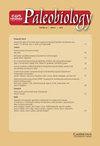苔藓植物进化过程中的生物和非生物因素以及灭绝的系统发育结构
IF 2.6
2区 地球科学
Q2 BIODIVERSITY CONSERVATION
引用次数: 0
摘要
鳄形目(Crocodylomorpha)是一个庞大而多样化的支系,其进化历史悠久,目前仅限于现代鳄鱼。Tethysuchia是一个半两栖类群,它跨越了两次生物危机:第二次大洋缺氧事件(OAE 2)和白垩纪/古近纪(K/Pg)危机。许多研究试图找到解释鳄科动物进化的驱动因素,但得出的结论却相互矛盾。对其中包括的类群进行研究可能会有所帮助。在此,我们利用系统发生学的统计分析方法研究了驱动四趾鳄进化的因素。首先,我们检验了 OAE 2 和 K/Pg 危机时特提斯类灭绝的系统发育结构。然后,我们利用系统发育比较方法检验了内在因素(体型、吻比例)和外在因素(温度、古纬度)对OAE 2和K/Pg危机时期特提斯类多样性演化的影响。最后,我们检验了温度是否影响了体型的演化。我们得出的结论是:(1)OAE 2和K/Pg危机期间,特提斯亚类的灭绝在系统发育上不是随机的;(2)虽然OAE 2之后特提斯亚类发生了重要的更替,但K/Pg危机之后特提斯亚类的多样性发生了爆炸性的增长,这可能与空虚的生态位的殖民化有关;(3) 在 OAE 2 危机之后,特提斯类生活在更温暖的环境中,这可能是由于全球变暖和纬度分布的变化造成的;(4) 在 OAE 2 和 K/Pg 危机之后,吻部比例发生了显著变化,这可能是由于生态位分隔造成的;(5) 体型与温度之间存在正相关,这可能是由于生长期延长造成的。本文章由计算机程序翻译,如有差异,请以英文原文为准。
Biotic and abiotic factors and the phylogenetic structure of extinction in the evolution of Tethysuchia
Crocodylomorpha is a large and diverse clade with a long evolutionary history now restricted to modern crocodilians. Tethysuchia is a less-inclusive clade of semi-amphibious taxa that crossed two biological crises: the second Oceanic Anoxic Event (OAE 2) and the Cretaceous/Paleogene (K/Pg) crisis. Numerous studies have sought to find the driving factors explaining crocodylomorph evolution, producing contradictory conclusions. Studies of included groups may be useful. Here, we study factors driving tethysuchian evolution using phylogenetically informed statistical analyses. First, we tested the phylogenetic structure of tethysuchian extinction at the OAE 2 and K/Pg crises. We then used phylogenetic comparative methods to test the influence of intrinsic (body size, snout proportion) and extrinsic (temperature, paleolatitude) factors on the evolution of tethysuchian diversity at the OAE 2 and the K/Pg crises. Finally, we tested whether temperature influenced the evolution of body size. We conclude that (1) extinction was not random in regard to phylogeny for Tethysuchia at the OAE 2 and K/Pg crises; (2) while an important tethysuchian turnover follows OAE 2, the K/Pg crisis was followed by an explosion in diversity of tethysuchians, probably linked to the colonization of emptied ecological niches; (3) tethysuchians lived in warmer environments after the OAE 2 crisis, possibly because of both global warming and latitudinal distribution shifts; (4) there is a significant change of snout proportion after the OAE 2 and the K/Pg crises, likely caused by niche partitioning; and (5) there is a positive correlation between body size and temperature, possibly because of a longer growth season.
求助全文
通过发布文献求助,成功后即可免费获取论文全文。
去求助
来源期刊

Paleobiology
地学-古生物学
CiteScore
5.30
自引率
3.70%
发文量
38
审稿时长
>12 weeks
期刊介绍:
Paleobiology publishes original contributions of any length (but normally 10-50 manuscript pages) dealing with any aspect of biological paleontology. Emphasis is placed on biological or paleobiological processes and patterns, including macroevolution, extinction, diversification, speciation, functional morphology, bio-geography, phylogeny, paleoecology, molecular paleontology, taphonomy, natural selection and patterns of variation, abundance, and distribution in space and time, among others. Taxonomic papers are welcome if they have significant and broad applications. Papers concerning research on recent organisms and systems are appropriate if they are of particular interest to paleontologists. Papers should typically interest readers from more than one specialty. Proposals for symposium volumes should be discussed in advance with the editors.
 求助内容:
求助内容: 应助结果提醒方式:
应助结果提醒方式:


